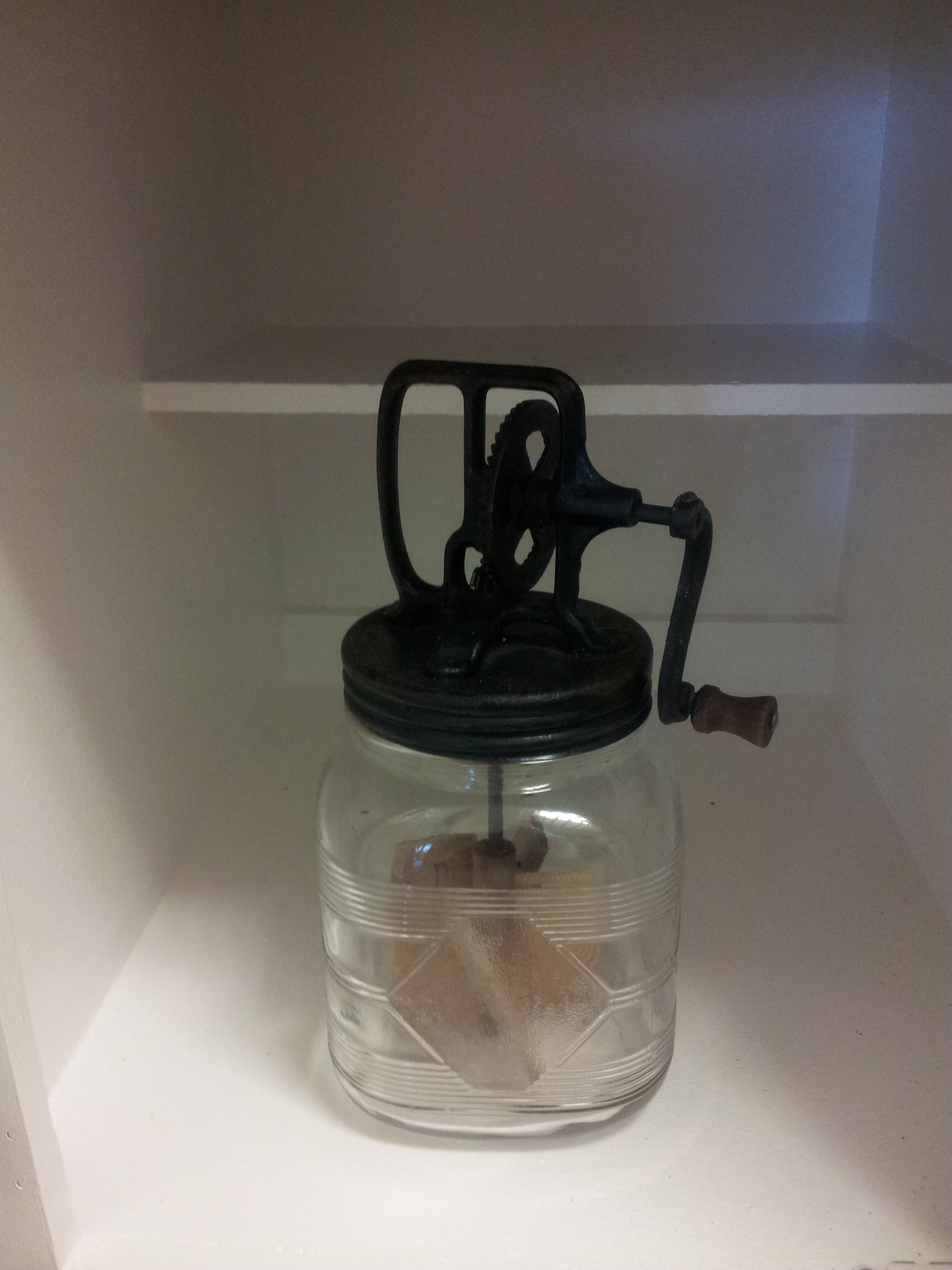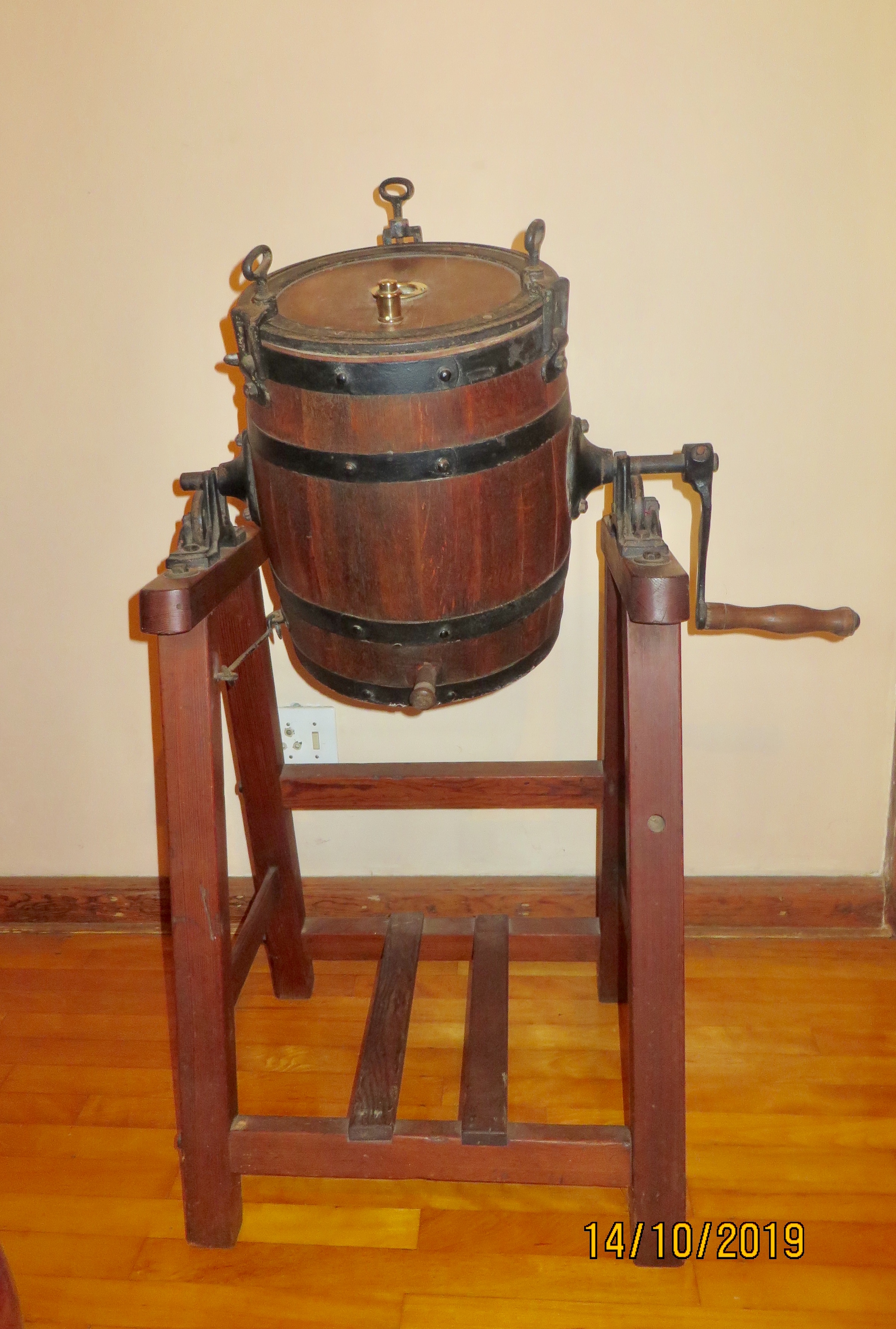Butter churn on:
[Wikipedia]
[Google]
[Amazon]

 A butter churn is a device used to convert
A butter churn is a device used to convert
 The use of butter is mentioned in
The use of butter is mentioned in
 The most historically prominent types of butter churns are the plunge churn, which is a container, usually made out of
The most historically prominent types of butter churns are the plunge churn, which is a container, usually made out of 
 The barrel churn was also used extensively. This type of churn was a barrel turned onto its side with a crank attached. The crank either turned a paddle device inside the churn, as in the paddle churn, or turned the whole barrel either horizontally or vertically, depending on its construction. Agitation of the cream in this manner converted the milk to butter. The barrel churn was one of the agricultural innovations of 18th century
The barrel churn was also used extensively. This type of churn was a barrel turned onto its side with a crank attached. The crank either turned a paddle device inside the churn, as in the paddle churn, or turned the whole barrel either horizontally or vertically, depending on its construction. Agitation of the cream in this manner converted the milk to butter. The barrel churn was one of the agricultural innovations of 18th century
Several types of butter churn illustrated and described
Traditional Czech butter churn
{{DEFAULTSORT:Butter Churn Food preparation utensils Butter
 A butter churn is a device used to convert
A butter churn is a device used to convert cream
Cream is a dairy product composed of the higher-fat layer skimmed from the top of milk before homogenization. In un-homogenized milk, the fat, which is less dense, eventually rises to the top. In the industrial production of cream, this process ...
into butter
Butter is a dairy product made from the fat and protein components of churned cream. It is a semi-solid emulsion at room temperature, consisting of approximately 80% butterfat. It is used at room temperature as a spread, melted as a condim ...
. This is done through a mechanical process, frequently via a pole inserted through the lid of the churn, or via a crank used to turn a rotating device inside the churn.
Etymology
The word “butter” is believed to be derived from the Greek word bou-tyron, the approximate meaning of which is “cow cheese”. However, some believe the word came from the Scythian culture, as theancient Greeks
Ancient Greece ( el, Ἑλλάς, Hellás) was a northeastern Mediterranean civilization, existing from the Greek Dark Ages of the 12th–9th centuries BC to the end of classical antiquity ( AD 600), that comprised a loose collection of cult ...
tended to herd sheep
Sheep or domestic sheep (''Ovis aries'') are domesticated, ruminant mammals typically kept as livestock. Although the term ''sheep'' can apply to other species in the genus '' Ovis'', in everyday usage it almost always refers to domesticate ...
and goats, whose milk is not as good for butter making as that of cows, which the Scythians primarily herded. The word "churn" is from the Old English
Old English (, ), or Anglo-Saxon, is the earliest recorded form of the English language, spoken in England and southern and eastern Scotland in the early Middle Ages. It was brought to Great Britain by Anglo-Saxon settlers in the mid-5th ...
''ċyrin,'' to churn. This is probably derived from the Old English ''cyrnel,'' "kernel," due to the appearance of butter grains after milk has been churned.
The butter churn gave its name to the milk churn, early examples of which were based on butter churns. The milk churn is not, however, used for the act of churning, but rather to transport milk.
History
biblical
The Bible (from Koine Greek , , 'the books') is a collection of religious texts or scriptures that are held to be sacred in Christianity, Judaism, Samaritanism, and many other religions. The Bible is an anthologya compilation of texts of ...
works and the earliest butter churn vessels belonging to Beersheba culture in Israel were found in Bir Abu Matar going back to Chalcolithic period between 6500–5500 BC.
The butter churn in Europe may have existed as early as the 6th century AD, as can be seen by what appears to be a churn lid found in Scotland dating from that era.
In the European tradition, the butter churn was primarily a device used by women, and the churning of butter was an essential responsibility along with other household chores. In earlier traditions of butter making, nomadic cultures placed milk in skin bags and produced butter either by shaking the bag manually, or possibly by attaching the bag to a pack animal, and producing butter simply through the movement of the animal. Some theorists believe this is how the butter creation process was discovered. Some cultures still use a process similar to this, whereby a bag is filled with milk, tied to a stick, and vigorously shaken.
Types
 The most historically prominent types of butter churns are the plunge churn, which is a container, usually made out of
The most historically prominent types of butter churns are the plunge churn, which is a container, usually made out of wood
Wood is a porous and fibrous structural tissue found in the stems and roots of trees and other woody plants. It is an organic materiala natural composite of cellulose fibers that are strong in tension and embedded in a matrix of lignin ...
, where the butter-making action is created by moving in a vertical motion a staff that is inserted into the top. This type of churn is also known as an ‘up and down’ churn, churning tub, plunger churn, plumping churn, knocker churn, plump-kirn, or plowt-kirn (where “kirn" is a Scots/Northern English word for churn). The staff used in the churn is known as the dash, dasher-staff, churn-staff, churning-stick, plunger, plumper, or kirn-staff.
Another prominent type of churn was the paddle churn, which was a container that contained a paddle, which was operated by a handle. The paddle churned the butter inside the container when the handle was turned.

 The barrel churn was also used extensively. This type of churn was a barrel turned onto its side with a crank attached. The crank either turned a paddle device inside the churn, as in the paddle churn, or turned the whole barrel either horizontally or vertically, depending on its construction. Agitation of the cream in this manner converted the milk to butter. The barrel churn was one of the agricultural innovations of 18th century
The barrel churn was also used extensively. This type of churn was a barrel turned onto its side with a crank attached. The crank either turned a paddle device inside the churn, as in the paddle churn, or turned the whole barrel either horizontally or vertically, depending on its construction. Agitation of the cream in this manner converted the milk to butter. The barrel churn was one of the agricultural innovations of 18th century Europe
Europe is a large peninsula conventionally considered a continent in its own right because of its great physical size and the weight of its history and traditions. Europe is also considered a Continent#Subcontinents, subcontinent of Eurasia ...
.
One particularly novel invention of note was the rocking chair butter churn. This device, invented by Alfred Clark, consisted of a barrel attached to a rocking chair. While the rocking chair moved, the barrel moved and churned the milk within into butter.Sabin, L. “What a Wild Idea.” Boys’ Life, Sep 1990. 80.1, p 32.
See also
* Butter-churn tower, named after its similarity to a type of butter churn.References
External links
Several types of butter churn illustrated and described
Traditional Czech butter churn
{{DEFAULTSORT:Butter Churn Food preparation utensils Butter